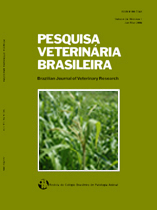 |
|
|
|
Year 2006 - Volume 26, Number 4
|

|
Plantas tóxicas para ruminantes no Seridó Ocidental e Oriental do Rio Grande do Norte
|
ABSTRACT.- Silva D.M., Riet-Correa F., Medeiros R.M.T. & Oliveira O.F. 2006. [Toxic plants for livestock in the western and eastern Seridó, state of Rio Grande do Norte, in the Brazilian semiarid.] Plantas tóxicas para ruminantes no Seridó Ocidental e Oriental do Rio Grande do Norte. Pesquisa Veterinária Brasileira 26(4):223-236. Hospital Veterinário, CSTR, Universidade Federal de Campina Grande, Campus de Patos, 58700-000 Patos, PB, Brazil. E-mail: franklin.riet@pesquisador.com.br
To determine the occurrence of plant poisoning in the Western and Eastern Seridó regions of the state of Rio Grande do Norte, 82 persons including farmers, agronomists and veterinarians were interviewed. The two more important toxic plants are Ipomoea asarifolia, which causes nervous signs in sheep, goats and cattle, and Aspidosperma pyrifolium, leading to abortion in goats, sheep and cattle. The abortive properties of this plant had been demonstrated experimentally in goats, but not in sheep and cattle. Some farmers mentioned the poisoning by A. pyrifolium as a cause of nervous signs in equidae and cattle. Poisoning by cyanogenic plants including Manihot spp, Anadenanthera colubrina var. cebil (=Piptadenia macrocarpa), Sorghum bicolor and Sorghum halepense are important in the region. Important is also poisoning by Prosopis juliflora in cattle and with less frequency in goats, poisoning by Crotalaria retusa in horses, sheep and cattle, and by Mascagnia rigida in cattle. Poisoning by Brachiaria decumbens and Enterolobium contortisiliquum is sporadic. Other less important toxic plants in the region are Indigofera suffruticosa, Ipomoea carnea, and Ricinus communis. Some farmers reported poisoning by Marsdenia sp affecting sheep and cattle, and also a group of swine fed with the roots of the plant; the leaves and the roots are experimentally toxic to ruminants causing nervous signs, without histologic lesions. Another poisoning demonstrated experimentally is caused by Tephrosia cinerea and results in ascitis with hepatic fibrosis in sheep. Six farmers reported poisoning by Nerium oleander, always in cattle that had access to the shrub after been cut, mixed or not with other plants. Farmers mentioned also poisoning by other plants with unknown toxicity, including Paullinia sp, Passiflora sp, Dalechampia sp, Portulaca oleracea, Luffa acutangula, Cereus sp, Leersia hexandra, and Stemodia maritima. Echinochloa polystachya and Pennisetum purpureum, which cause nitrite poisoning were mentioned by some farmers as cause of cattle mortalities. One farmer mentioned an outbreak of poisoning in cattle and goats by Dieffenbachia picta which had been cut and left to the animals. |
| |
|
|
| |
|
 |